 There’s a certain attraction to time travel stories. Sometimes, they’re about comparing the present to the past, particularly by sticking a fish out of their water. Other times, they’re used as a way to think about the future and the promise it holds. Most of them really come down to a simple question: what would the present be like if things had gone differently in the past? Ultimately, time travel stories are more often than not morality tales about appreciating what we have and who we are. A warning about greed and how it can leave you with less than you had. A means of dealing with regret and the paralysis it can bring. Well, except for Back to the Future. That one’s about making out with a younger version of your hot mom and getting a new truck.
There’s a certain attraction to time travel stories. Sometimes, they’re about comparing the present to the past, particularly by sticking a fish out of their water. Other times, they’re used as a way to think about the future and the promise it holds. Most of them really come down to a simple question: what would the present be like if things had gone differently in the past? Ultimately, time travel stories are more often than not morality tales about appreciating what we have and who we are. A warning about greed and how it can leave you with less than you had. A means of dealing with regret and the paralysis it can bring. Well, except for Back to the Future. That one’s about making out with a younger version of your hot mom and getting a new truck.
The first half of Steins;Gate ($19.99) is kind of like Back to the Future. It’s about how time travel could be used to fulfill wishes and clean up regrets. It dives happily into the science, both real and theoretical, behind its time travel mechanics, and spends a long time acquainting you with its cast of characters. The characters aren’t really mature enough to understand the consequences of their actions. It’s hard to blame them for that, though. They’re young and idealistic, and it all seems to be going pretty well for everyone until everything comes unglued. It’s hard to pull off an entertaining story about a bunch of kids getting whatever they want in between lengthy spews of technobabble, though, so things inevitably start to go awry. Oh my, do they go awry.
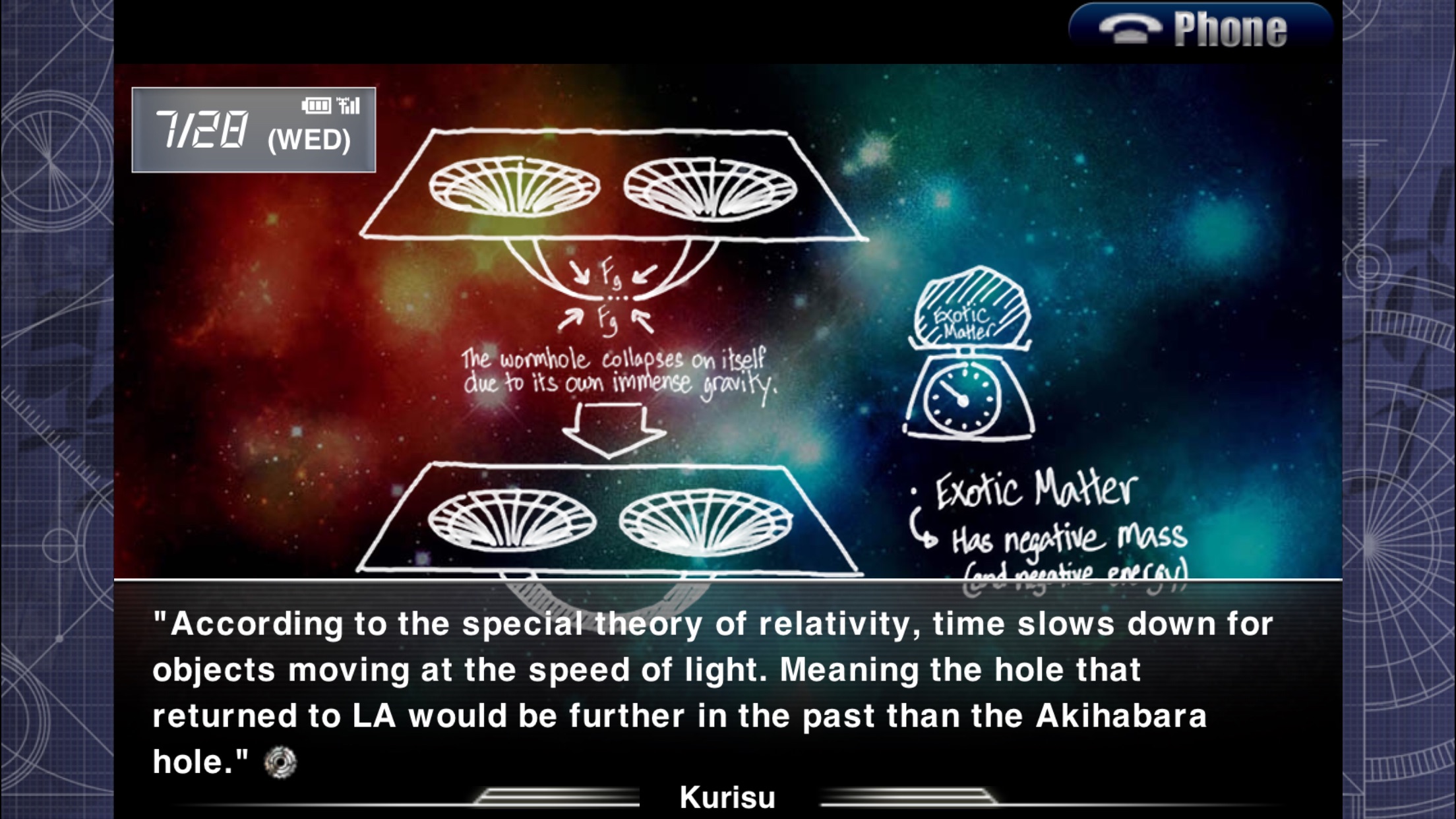
Steins;Gate is a visual novel, and like most games in that genre, you’ll be spending most of your time reading and tapping to scroll the text. The interactivity here is minimal even by this genre’s standards. You’ll never even be given a single explicit choice in the main text. Your only influence on the story comes via your character’s mobile phone. You’ll receive occasional texts and emails from other characters, and can choose to reply with one of two or three different responses. You can also ignore those texts, which counts as a choice in and of itself. How you reply generally has little effect on the course of the main story, though you can only reach the game’s best ending by responding to certain texts in a certain way. You’ll also use your character’s phone as the primary means of activating the time machine, with most of the game’s six endings tied up in whether or not you choose to change the past at critical points in the story. These few specific instances are important choices, as one option will shunt you off towards an ending while the other moves the main story forward.
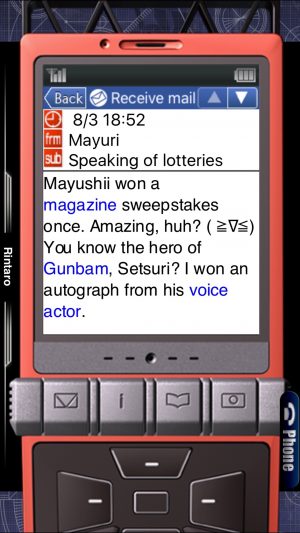 Unless you peek at a strategy guide, getting the best ending of the game will likely require a lot of trial and error. The game doesn’t do a great job of highlighting the handful of important texts among the large assortment you receive, and it’s certainly not clear which reply will lead you to the best result. You have to be quick to respond, as well. Let the main story scroll more than a few lines, and you won’t ever be able to reply to that message you just received. This isn’t ideal in any case, but it’s particularly bad in Steins;Gate due to the length of the adventure. I was able to unlock four of the six endings on my first playthrough thanks to frequent saves, and that took just under 20 hours. Since the first flag for the best ending occurs only a few hours into the story, it’s very likely you won’t notice you’ve missed anything until it’s far too late to retrace your steps. It gives you a reason to play again, I’ll grant, but I’m not sure that replaying a 20-hour visual novel is something that a lot of people are willing to do, especially given that the story is virtually identical up until the very end.
Unless you peek at a strategy guide, getting the best ending of the game will likely require a lot of trial and error. The game doesn’t do a great job of highlighting the handful of important texts among the large assortment you receive, and it’s certainly not clear which reply will lead you to the best result. You have to be quick to respond, as well. Let the main story scroll more than a few lines, and you won’t ever be able to reply to that message you just received. This isn’t ideal in any case, but it’s particularly bad in Steins;Gate due to the length of the adventure. I was able to unlock four of the six endings on my first playthrough thanks to frequent saves, and that took just under 20 hours. Since the first flag for the best ending occurs only a few hours into the story, it’s very likely you won’t notice you’ve missed anything until it’s far too late to retrace your steps. It gives you a reason to play again, I’ll grant, but I’m not sure that replaying a 20-hour visual novel is something that a lot of people are willing to do, especially given that the story is virtually identical up until the very end.
The developers do their best to put a bandage on it, though. You can use various gestures to fast-forward through text you’ve read, with the game only stopping when you hit a decision point or a new event. Doing that, you can speed through the game in only a few hours, which makes the prospect of replaying it a little more palatable. I’d recommend saving yourself some heartache and checking a guide for the best ending on your second run through, however. Replaying once has some appeal thanks to the nature of the story, but multiple playthroughs in search of the right daisy-chain of replies could get old quickly. That all being said, you’ll almost certainly want to see that best ending. The other endings vary in degrees of good results versus bad results, but the only real happy ending is the ultimate one. You won’t see what really happens unless you complete it.
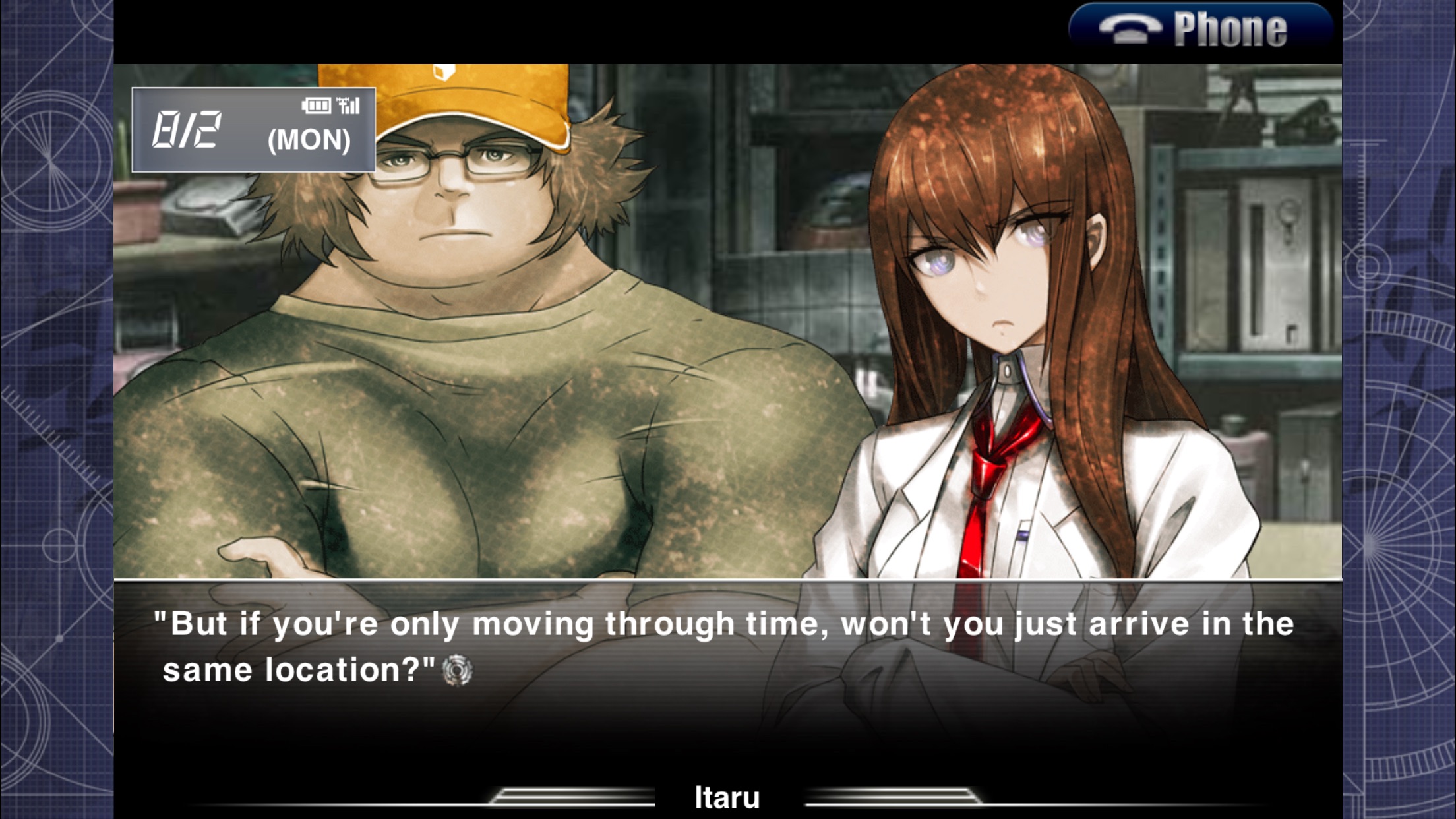
Those who like to hunt for achievements will be more satisfied with the game mechanics, I think. There are a lot of interesting ones to hunt for in Steins;Gate, and many of them require you to do some counter-intuitive things. You can check your progress on those achievements from the in-game menu, so finding all of them doesn’t feel as aimless as it sometimes does in other games. Oh, and in case you miss it, you can bring up that menu at almost any time during the game by tapping two fingers on the screen. The game doesn’t really mention that clearly, and I’m guessing you’ll be wanting to save your game beyond the quick-save at some point. From that menu, you can check out your collection of artwork that you’ve encountered so far, read a handy glossary that explains some of the more esoteric terms, and even play around with the volume levels of each character’s voice.
You’re probably not going to pick up Steins;Gate for the gameplay. No, the important things here are the story and the characters, and this game does an excellent job with both. The first several hours are as slow and thick as molasses, but after seeing the whole thing through, it makes sense. For all of its high-concept science-fiction ambitions, Steins;Gate is a surprisingly personal story. It spends its first half setting up the rules of its world and letting you get to know, and maybe even love, each member of the cast. It’s about the thrill of discovery, scientific and interpersonal, and for better or worse, the writers decided to build all of that without any major adversaries to speak of. The conflict here resonates well, since it’s really about working with varying personalities to achieve a seemingly-impossible goal. Bonds are built, breakthroughs are achieved. It stretches on so long that you might become complacent with its breeziness. More’s the better for when it kicks the chair out from under you.
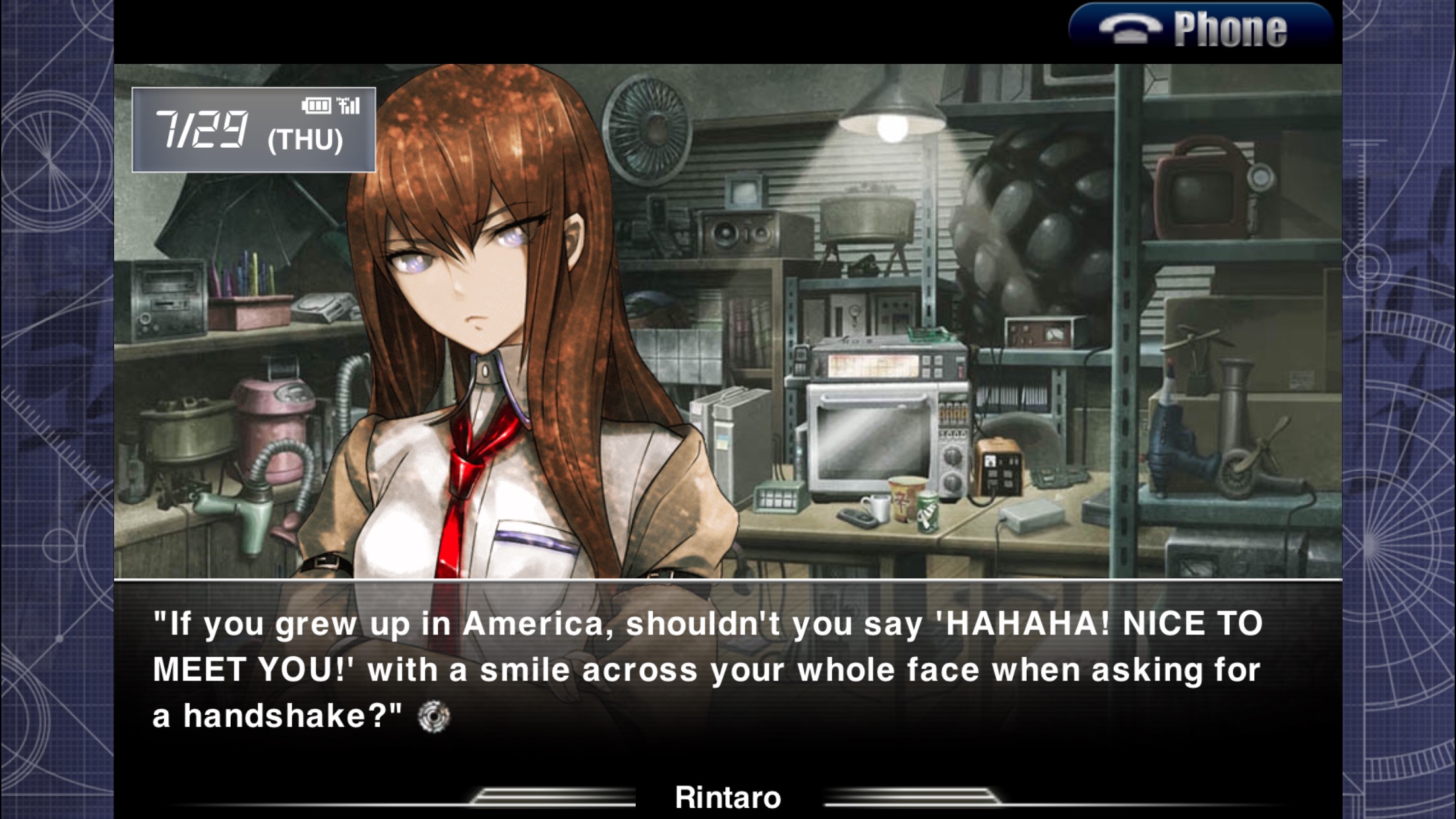
There isn’t a single major character in Steins;Gate who actually is what they present themselves to be. Everyone is holding on to some secret or another. Some are benign. Some are heartbreaking. Some are much, much worse. You’ll likely see some of these turns coming if you’re up to date on your tropes. The tricky thing is, Steins;Gate is also quite aware of tropes, and if it throws you a few easy pitches, you can’t be sure that it isn’t just lulling you into false confidence for when it’s ready to throw a real curveball. This two-sided nature is best represented by the main protagonist, Okabe Rintarou. He’s a young university student with big ambitions, which is hardly an unusual thing. But Okabe is almost completely obfuscated in the early half of the game by his made-up persona, Hououin Kyouma, the insane mad scientist. He speaks with a dramatic flair that comes right out of the worst anime, acts as though his right arm is possessed by a demon, and generally carries on like an obnoxious, paranoid jerk. He has his reasons for behaving that way, and the mask does eventually slip, but until it does, you’re stuck seeing the Steins;Gate world through the eyes of its least-likable character.
That said, even Kyouma’s irritating personality is an important bit of set-up. I don’t want to spoil the story by going into great detail, but as rough as the first several hours are, nothing is put in there without good reason. It lobs bricks in the air one after another until you get bored waiting for even one of the bloody things to come down, but that’s because it’s looking to bury you in them later. When the first one finally lands, you may very well have trouble putting the game down until you’ve seen the credits. That was certainly the case for me. In the end, there were a couple of sections throughout the story that I didn’t care for as much. Some of the dating aspects feel forced, leaving you with ill-fitting, false endings that don’t fit the game well at all. The story goes pretty dark in general in the second half, but a couple of sections go shockingly far. I can see the point in these scenes, at least, but I’m not sure what little narrative purpose they offer is worth the damage done to the overall pacing. Again, I don’t want to spoil much, but if you’re uncomfortable with topics like sexual violence, suicide, or murder, this might not be the game for you. Steins;Gate puts its characters through the wringer, and it’s not a pretty sight.

It’s a story worth experiencing, though. Like most time travel stories, there are a couple of hand-waves and, if you look hard enough, a plothole or two. On the whole, given its ambitions, the plot is surprisingly cohesive. The subtle foreshadowing starts from virtually the first few sentences in the game, and you probably won’t notice any of it until you finish the game and play it again with your new knowledge in hand. Apart from being a tightly-designed story, it’s also clearly the work of people who are in love with the time travel concept in all of its forms. Steins;Gate will drop references to astrophysics, existential philosophy, net culture, Hollywood movies, and maid cafes within sentences of each other, all with the sort of exuberance that is evidence of appreciating those things rather than cynically cashing in on them. The only problem is that if you’re a total layperson to any of those things, you might find yourself feeling a little lost at times. That glossary of terms is there for a good reason. If you’re a fan, though? This game is speaking to you. Yes, directly to you.
This mobile version of the game is quite good all-around. Though the original version released in Japan more than five years ago, it’s been well-maintained to keep up with new hardware and it shows. The only real issue with the iOS version is, unfortunately, connected to its original age. When Steins;Gate originally released, it was common for iPhone and iPad versions to be separate apps, and that’s the case here. Combined with the relatively high price and the lack of iCloud support, this means you’ll probably only want to pick one of the two. My advice is to grab the version you would be most comfortable spending 20 hours reading. All things equal, I’d go with the iPhone version simply because it’s easier to rotate the screen to use the in-game phone functions, but I certainly won’t begrudge anyone who wants to read a lot of text on a bigger screen rather than a smaller one. As with other versions of the game, there’s a considerable amount of voice acting, but it’s Japanese only.
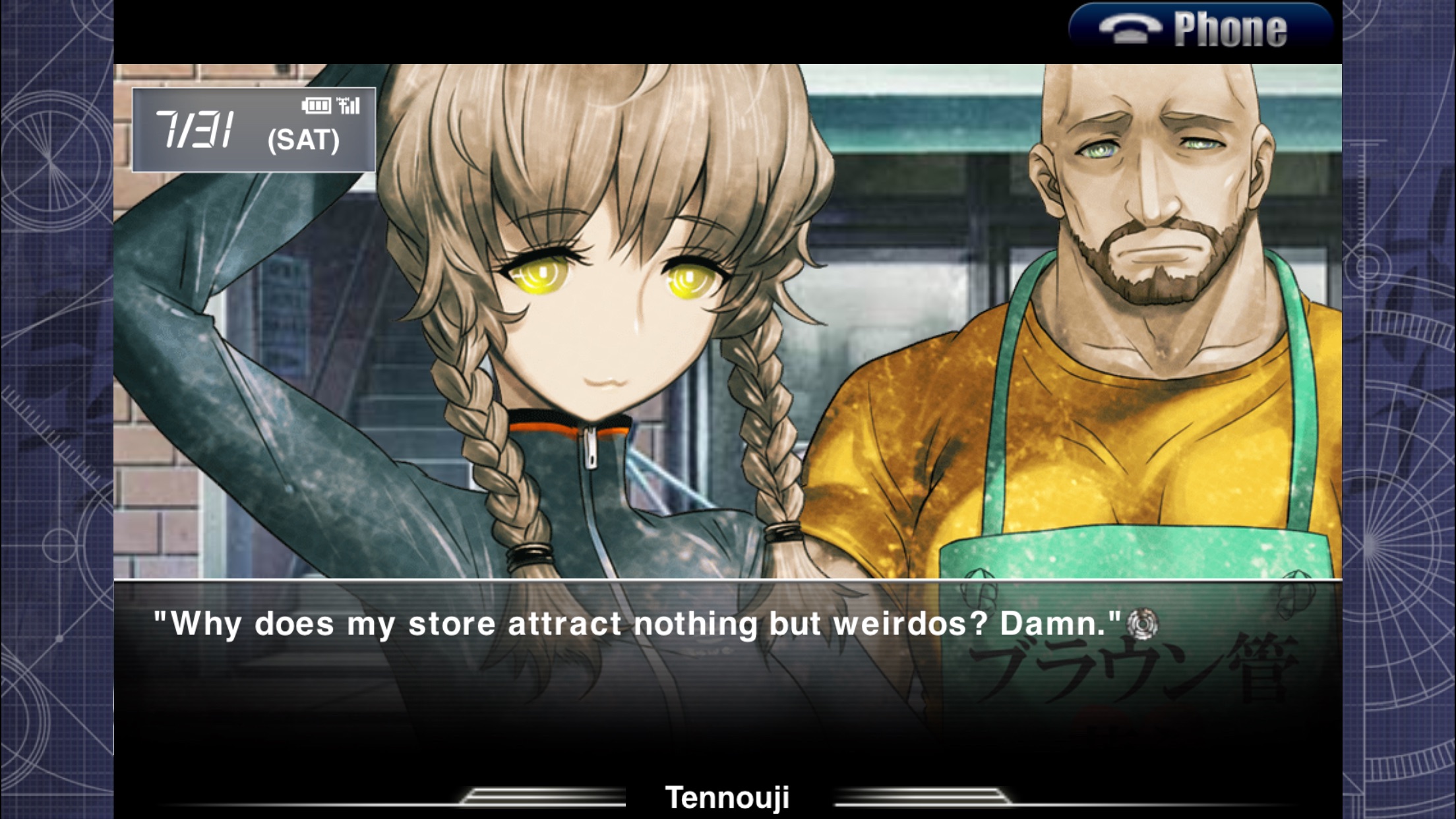
If you enjoy a good time travel yarn and are willing to be patient with the initial build-up, Steins;Gate is an incredible experience. It took me a week to drag myself through the first few hours, but once the story got cooking, I cleared the rest of the game over a weekend binge simply because I couldn’t get the thing out of my mind until I saw it through. The lack of a universal app is a serious bummer, and the game is certainly a little more expensive than we usually see on iOS, but the game itself is unlikely to let you down thanks to its terrific story and interesting characters. It’s easy to see why this is one of the more revered visual novels of the last decade.